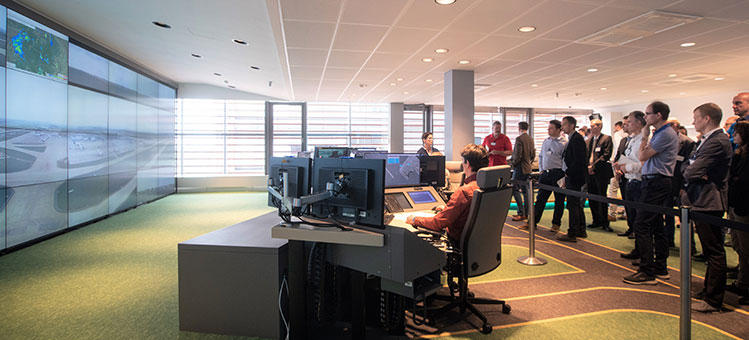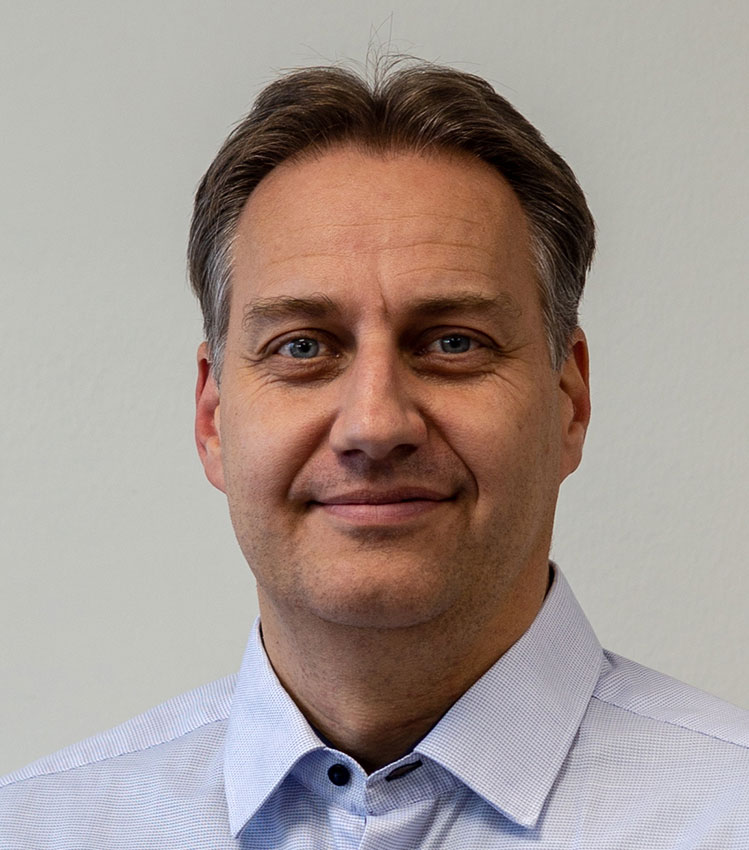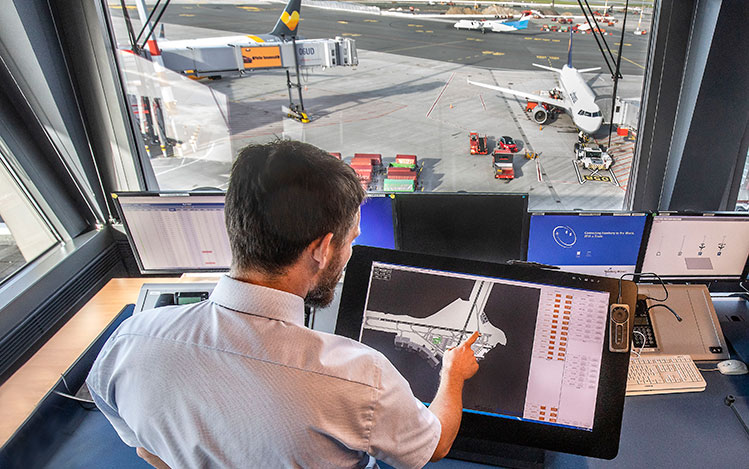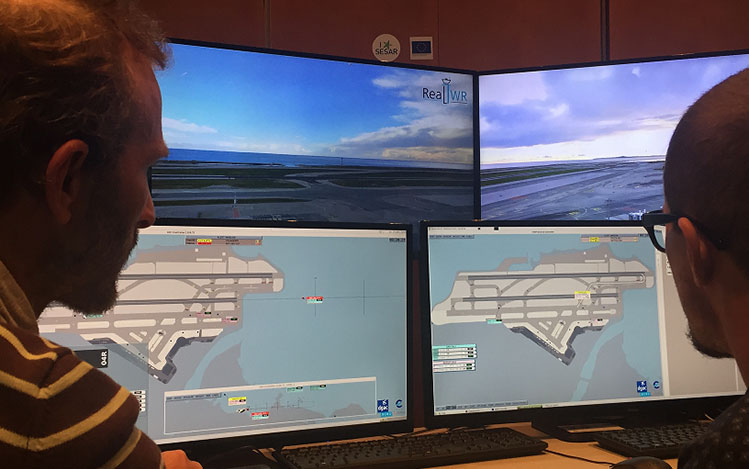
IAO demonstrations by Indra and HungaroControl at the HungaroControl remote tower facility in Budapest. (Photo: HungaroControl)
Nice, Hamburg and Budapest. Three European airports with very distinct operational characteristics and challenges. But over the last three years, these three airports have acted as demonstrator sites to showcase the potential of tech solutions developed within the framework of the SESAR research and innovation programme. In this article, Steffen Loth, Project Manager of Integrated Airport Operations, a SESAR Joint Undertaking very-large scale demonstration, explains how this can pave the way for the implementation of solutions capable of improving airside operations at airports in Europe.
Airports are not only vital nodes in the air traffic management (ATM) system, they are also catalysts for change. This can be seen through the research and development activities carried out at airports, big and small, across Europe over the last decade in the SESAR research and innovation programme. Airports are showing a real appetite to make use of the latest technologies available to improve the efficiency of their operations and, ultimately to provide their customers, both passengers and airlines, with a better service and experience. More efficient airport operations has a knock-on benefit for the overall air traffic management network, and ensures the mobility and regional connectivity across the continent.
The SESAR programme looks at what technologies can be developed for increased runway throughput, integrated surface management, airport safety nets, total airport management and remote towers. These technologies address not only the business and operational needs of large airports, but also those of medium and smaller airports, recognising the diversity of airports that make up Europe’s air transport network.
Putting the solutions to the test
To prove the applicability of these solutions and to encourage their early take-up, the SESAR Joint Undertaking and its partners put these solutions to the test in close to real operational environments in so-called very-large scale demonstrations. The Integrated Airport Operations (IAO) project is one of these demonstrations. In the last three years the international IAO team explored mature solutions for three areas of air traffic management at airports, organising large-scale demonstrations designed to support the tasks of tower and apron controllers as a means of ensuring greater efficiency:

Steffen Loth, Project Manager of Integrated Airport Operations, a SESAR Joint Undertaking very-large scale demonstration.
Digital ‘taxiing manager’
The first solution – automated assistance to controllers for surface movement planning and routing – comprises a route-planning tool that makes automated planning of aircraft routing available to apron and ground controllers. The system calculates ideal taxi routes for each aircraft, which it then proposes to the controllers, although the operator can change them at any time. It reacts continuously to changing
circumstances and adjusts its planning accordingly. In addition to increasing efficiency by optimising routes, the aim is to improve the situational awareness of the controllers.
No congestion at departure
The second solution – pre-departure sequencing supported by route planning – builds on the optimised taxi routes and is intended to ensure that engines are started at the latest possible moment – thereby minimising the environmental impact. This is achieved by moving away from making general assumptions about taxi times to more precise values that are calculated for each individual surface movement, depending on the current traffic situation. In addition to more accurate departure planning, this approach improves fuel efficiency and reduces noise, as well as carbon dioxide emissions at the airport, as the engines only run for as long as necessary.
Enhanced safety nets
The third solution – airport safety nets for controllers – draws on available information to enable new ‘safety nets’ at airports. These new safety nets can alert air traffic controllers when traffic deviates from air traffic control (ATC) instructions or procedures, enabling prompt reactions. In addition, the system can help detect conflicting ATC clearances during runway operations.

IAO demonstrations tested by DLR and SINTEF at Hamburg Airport. (Photo: Michael Penner)
Testing in live operations
The IAO team implemented the solutions at three different airports to see how they could be broadly applied despite significantly different local characteristics. Hamburg Airport, for instance, has a dependent, crossing runway system with short taxi times and limited routing alternatives. This differs from Nice Côte d’Azur Airport which has a dependent, but parallel runway system and a complex surface layout, where traffic congestion takes place daily during the peak season. Budapest Airport also has a system of dependent, parallel runways and a complex arrangement of taxiways, but the terminal located between the runways and a traffic distribution more even along the whole year.
Over the course of the project, the participating partners installed the infrastructure for on-site testing and connected the demonstrators to the operational airport systems. Doing so enabled access to live data from flight operations, such as the current traffic situation and the associated flight plans allowing for a very close-to-operational environment. All exercises were performed with local air traffic controllers as realistically as possible. Controllers were therefore able to provide their immediate impressions, feedback and assessments.
Michael Eggenschwiler, Chief Executive Officer of Hamburg Airport, welcomed the activities: “We very much appreciate the fruitful collaboration we have had with the partners in the large-scale demonstration project. With the innovative developments for optimised surface movements, the partners were able to conduct research under realistic conditions in our ‘contingency room’. IAO was able to directly test systems in live operations together with our controllers.”
Anna Petrovai, Head of Aerodrome Control Unit at HungaroControl, confirms the performance of the system at Budapest and that it works according to expectations: “We have tested out the new solution from Indra, and we like what we see. Integrating more automatic alerts and functionality into the A-SMGCS helps air traffic controllers work more efficiently and allows more time to react in case of non-conformance or conflicting clearances.”
Christelle Pianetti, Head of the Airports, Towers and TMA unit at DSNA, the French Air Navigation Services Provider, emphasised the crucial contribution of this large-scale demonstration in order to bring more maturity to these innovative SESAR solutions: “This demonstration made clearer the operational benefits of the solutions in terms of predictability, safety and environment. Moreover, it enabled us to assess the adaptations needed for the given environment and its characteristics.”

IAO demonstrations by DSNA at Nice Côte d’Azur Airport. (Photo: IAO partners)
Promising demonstrations for improved routing and individual planning
The IAO very large-scale demonstration is a major step forward for the implementation of innovative ATM solutions at airports. The innovations emerging from the SESAR research and innovation programme are showing their potential to support airports and the work of controllers. At the same time, the demonstration has thrown light on some prerequisites that need to be carefully considered before deployment. For instance. routing and planning as well as pre-departure sequencing essentially rely on highly accurate and up-do date airport layout and flight information data but also on detailed knowledge of operational procedures. Safety nets need to be configured precisely to be accepted and future users have to be trained adequately.
The three solutions are among the ATM sub-functionalities outlined in the European Union’s Pilot Common Project (PCP), a European regulation binding the EU Member States and their operational stakeholders, including a number of airports, to deploy in a synchronised and timely manner the most essential SESAR operational improvements.
The final evaluation results are expected to be published in early 2020.
The partners
Indra Navia, the Norwegian branch of the global technology company Indra, in collaboration with the Hungarian air traffic control organisation HungaroControl, was responsible for the demonstration at Budapest Airport. The demonstration at Nice Côte d’Azur Airport was carried out by the French Air Navigation Service Provider DSNA (Direction des Services de la navigation aérienne), while the demonstration at Hamburg Airport was coordinated by the German Aerospace Center (DLR) and executed together with the Norwegian research institution SINTEF (Stiftelsen for industriell og teknisk forskning). DLR is responsible for overall coordination of the IAO project.
More information
www.iao-project.eu







